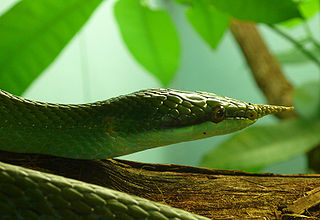
Eublepharis is a genus of terrestrial geckos native to eastern and southwestern Asia. The genus was first described by the British zoologist John Edward Gray in 1827. The etymology of their name is 'eu' = good (=true) |'blephar' = eyelid, and all have fully functional eyelids. Members of this genus are found in eastern and southwestern Asia. These geckos are sturdily built. Their tail is shorter than their snout–vent length, and their body is covered with numerous wart-like bumps. The toes do not have adhesive lamellae or membranes. Like all members of Eublepharidae, they are primarily nocturnal. Included in this group is the popular pet leopard gecko Eublepharis macularius.

Goniurosaurus is a genus of geckos in the family Eublepharidae. The genus contains 25 species. Members species are known by various common names including cave geckos, ground geckos, leopard geckos, and tiger geckos. Members of this genus are found in China, Japan, and Vietnam. For this reason they are also known commonly as Asian geckos.

Cyrtodactylus is a diverse genus of Asian geckos, commonly known as bent-toed geckos, bow-fingered geckos, and forest geckos. The genus has 361 described species as of 2024, which makes it the largest of all gecko genera.

The genus Sphenomorphus – vernacularly also known as the common skinks – currently serves as a "wastebin taxon" for numerous skinks. While most or all species presently placed here are probably rather close relatives, the genus as presently delimited is likely to be not monophyletic and is in need of review. Some species in this genus have been moved to Pinoyscincus.

The leopard gecko or common leopard gecko is a ground-dwelling gecko native to the rocky dry grassland and desert regions of Afghanistan, Iran, Pakistan, India, and Nepal. The leopard gecko is a popular pet, and due to extensive captive breeding it is sometimes referred to as the first domesticated species of lizard.

The golden gecko, also known commonly as Baden's Pacific gecko, is a species of lizard in the family Gekkonidae. The species is native to Vietnam.
Takydromus haughtonianus, commonly known as the Goalpara grass lizard, is a species of lizard in the family Lacertidae. The species is endemic to India.

Kuroiwa's ground gecko, also known commonly as Kuroiwa's eyelid gecko, Kuroiwa's leopard gecko, the Okinawan ground gecko, the Ryukyu eyelid gecko, and the Tokashiki gecko, is a species of lizard in the family Eublepharidae. The species is endemic to the Okinawa Islands in the Ryukyu Archipelago, Japan.

The Turkmenistan eyelid gecko or Turkmenian eyelid gecko is a ground-dwelling lizard native to Turkmenistan and northern Iran. It inhabits rocky and stony foothills and slopes at elevations up to 1,000 m (3,300 ft) above sea level. It is oviparous, typically laying clutches of two eggs. Mainly insectivorous, it may also eat smaller vertebrates. Like many other lizards has the ability to shed its tail (autotomy).
Switak's banded gecko, also commonly known as the barefoot banded gecko, the barefoot gecko, and Switak's barefoot gecko, is a species of lizard in the family Eublepharidae. The species is indigenous to the extreme southwestern United States and adjacent northwestern Mexico.

Ilya Sergeyevich Darevsky was a Soviet Russian zoologist-herpetologist and a corresponding member of the Russian Academy of Sciences. During his career he described 34 species of amphibians and reptiles. Darevskia, a genus of Caucasian rock lizards, is named after him.
The Vietnamese leopard gecko or Chinese tiger gecko is a species of lizards in the family Eublepharidae. It is found in the Cao Bằng Province of Vietnam and Guangxi in China. The scientific species name, is from the Latin, aranea, which means "spider", due to the spindly, spider-like form of this species.

The rhinoceros ratsnake, also known commonly as the rhinoceros snake, rhino rat snake, and Vietnamese longnose snake, is a species of nonvenomous ratsnake in the family Colubridae. The species is found from northern Vietnam to southern China. It has a prominent, distinctive, scaled protrusion on the front of its snout, which has led to its common naming after a rhinoceros.
Cyrtodactylus badenensis is a gecko from Indochina, particularly South Vietnam.

Goniurosaurus bawanglingensis is a species of geckos endemic to the Hainan Bawangling National Nature Reserve in the southwest part of Hainan Island, China.
Goniurosaurus luii is a species of gecko, a lizard in the family Eublepharidae. The species is endemic to China and Vietnam.

Goniurosaurus hainanensis is a nocturnal species of gecko endemic to the Hainan Island of China. Its common names are the Chinese cave gecko, Hainan Cave Gecko or simply cave gecko. The exotic pet trade has been driving numbers of this rare species down since its categorization in the early 2000s, and could eventually lead to its extinction. In recent years, the population has stabilized.
Goniurosaurus toyamai, also called commonly the Iheja ground gecko, the Iheyajima leopard gecko, and Toyama's ground gecko, is a species of lizard in the family Eublepharidae. The species is endemic to the island of Iheyajima in the Ryukyu Islands (Japan).
Cyrtodactylus caovansungi is a species of gecko, a lizard in the family Gekkonidae. The species is endemic to Vietnam.
The barred gecko is a species of lizard in the family Gekkonidae. The species is endemic to Nepal.












